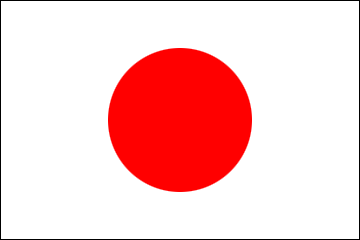Through the Eyes of the former Consul General Yamada (June, 2017 - July, 2020)
2018/4/18

Miss Tokushima who lives in Spokane
In the beginning of March, Miss Tokushima appeared in Spokane. With that said, she is not a human. She is a doll that was exchanged ninety years ago as an ambassador for friendship and goodwill between the United States and Japan. The place of her visit was Mukogawa Women’s University’s branch school in Spokane, Washington that was established in 1990. The students in the English-language department at this Nishinomiya-based university immerse themselves in the study of the English language for several months in Spokane. Early in March every year, the university displays a seven-step Hina doll set in the gymnasium and welcomes local elementary school students to an event that introduces Japanese culture. On that day, the city’s museum that stores Miss Tokushima brings her to the university’s gymnasium and places her center stage where around three hundred people can enjoy her beautiful presence.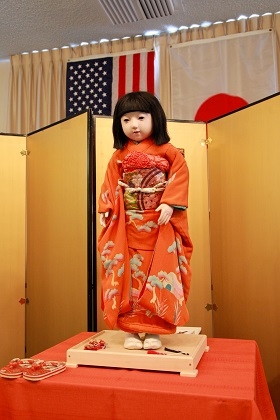 |
| Miss Tokushima - Hina Matsuri at Mukogawa Fort Wright Institute in Spokane, WA (Courtesy of Follger Photography) |
There is a song that is well known in Japan called “The Blue-Eyed Doll” (Aoime no Oningyo). This song (lyrics by Ujo Noguchi and composed by Nagayo Motoori) was released in 1921. When the Great Kanto Earthquake occurred in 1923, money was donated from all around the world, but the one who sent the largest amount was the United States. The song “The Blue-Eyed Doll” was sung in the United States when asking for donations.
Soon after, the Immigration Act of 1924 was established, and relations with Japan worsened. Serving as the head of a U.S.-Japan Relations Committee in New York and as a past American missionary in Japan, Sidney Gulick was sorely troubled by the deterioration of ties. He thought that there had to be a way to promote friendship between the two countries. When he heard this song, and with an interest in Japanese dolls for some time, he came up with an idea where at the grassroots level, dolls would be exchanged for children to foster friendship in their hearts. After making a proposal called “Let’s send dolls for Japan’s Hina Matsuri (Doll Festival)” throughout the United States, 2.7 million people responded, and 11,239 dolls were sent to Japan. In 1927, the dolls traveled with letters, passports, and/or tickets and were sent to elementary schools throughout Japan.
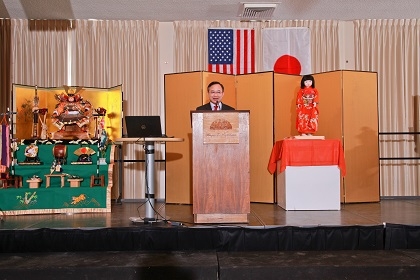 |
| Consul General Yamada at the Hina Matsuri celebration - 'Hina Matsuri at Mukogawa Fort Wright Institute in Spokane, WA' (Courtesy of Follger Photography) |
In response, Japan’s Shibusawa Eiichi, a famous industrialist, proposed, “Let’s send dolls to the United States for Christmas!” Two and a half million elementary school students whose schools received American dolls donated, and with that money, 58 Ichimatsu dolls were commissioned to doll makers. With letters, tickets, and passports, the dolls were sent all over the United States. Each doll was also accompanied by elaborately made “wedding items” and other accessories, each doll costing about 350 yen to make. When you think about the fact that an elementary school teacher’s monthly income was less than 60 yen at that time, with inflation taken into account, one doll would be about 2.5 million yen today (more than 22,000 USD), so it was a very high-class doll. The dolls were exhibited in museums and other public places throughout the United States.
However, U.S.-Japan relations continued to worsen, and both countries went to war against the other. In Japan, the “blue-eyed dolls” became subjects of hatred as they represented the enemy’s face. Most of them were mindlessly lost. However, in the 1970s, the dolls were re-discovered. It turned out that some dolls were hidden and protected during the war by kind-hearted people. Currently, 252 dolls have been confirmed. On the other hand, many of the Ichimatsu dolls sent from Japan were well-preserved during the war and 44 of them are still around currently. Miss Tokushima is one such example.
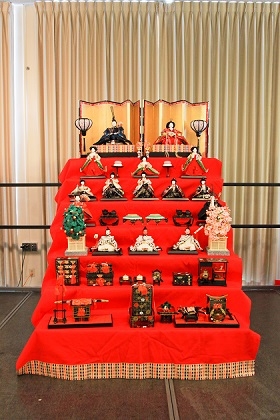 |
| Seven-step Hina Doll Set - Hina Matsuri at Mukogawa Fort Wright Institute in Spokane, WA (Courtesy of Follger Photography) |
Continuing this tradition of doll exchange in the present day, Mukogawa Women’s University annually gives a doll to a local elementary school in Spokane and shares the history of the U.S.-Japan doll exchange and the thousand-year tradition of Hina Matsuri. When I experienced this interaction during my visit to Spokane this past March, I noticed that every time elementary school students were correct during the quiz about the doll exchange, everyone roared with cheer. It might just be my imagination, but it seemed that Miss Tokushima was looking at this scene with content.
Nishinomiya and Spokane: Sister Cities
That same day, Spokane Mayor David Condon arrived during lunchtime at the school. Spokane became sister cities with Nishinomiya, Hyogo Prefecture in 1961. That connection allowed for the branch school of Mukogawa Women’s University, based in Nishinomiya, to be built in Spokane. Spokane is the second-most populated city in Washington State and the recent opening of medical industry facilities and hospitals have contributed to the city’s vibrant growth. The energetic Mayor Condon stated that the motto of its government is a “smarter, healthier, safer Spokane,” and he spoke about his passion and vision for the city. Among its many sister cities, Nishinomiya is the most active.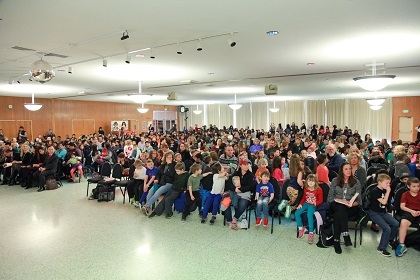 |
| Elementary school students at the Hina Matsuri celebration - 'Hina Matsuri at Mukogawa Fort Wright Institute in Spokane, WA' (Courtesy of Follger Photography) |
